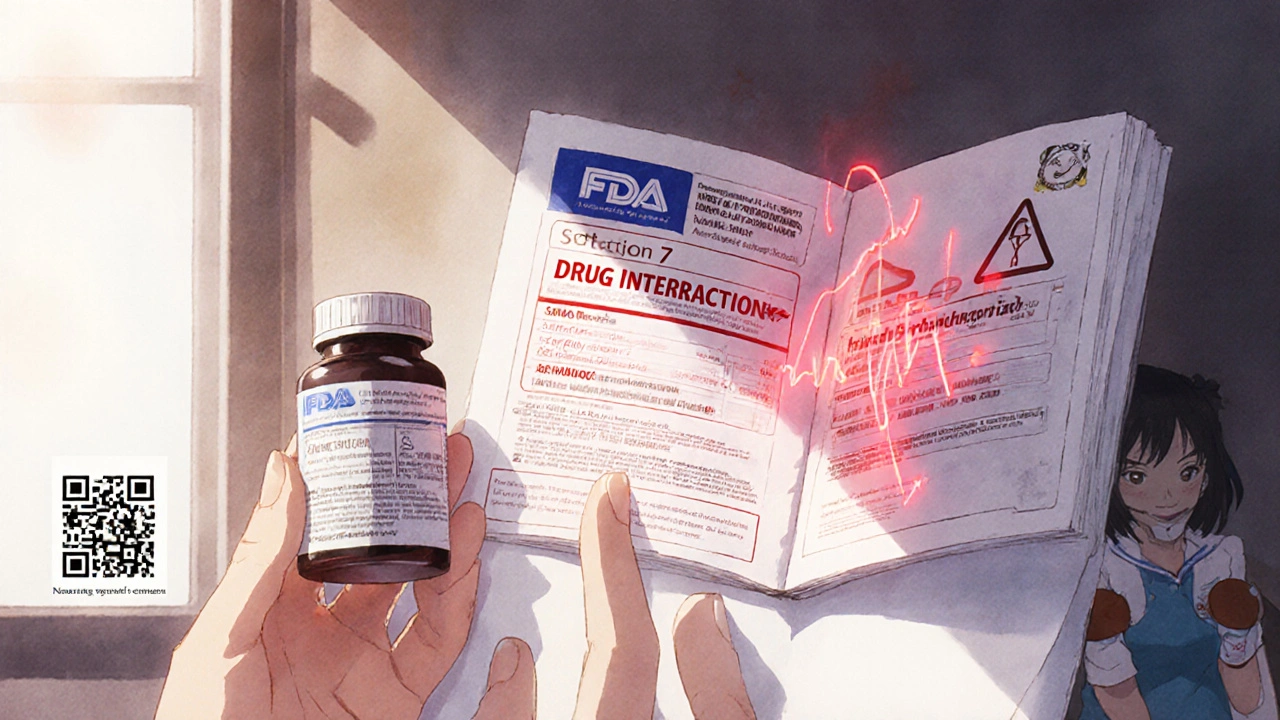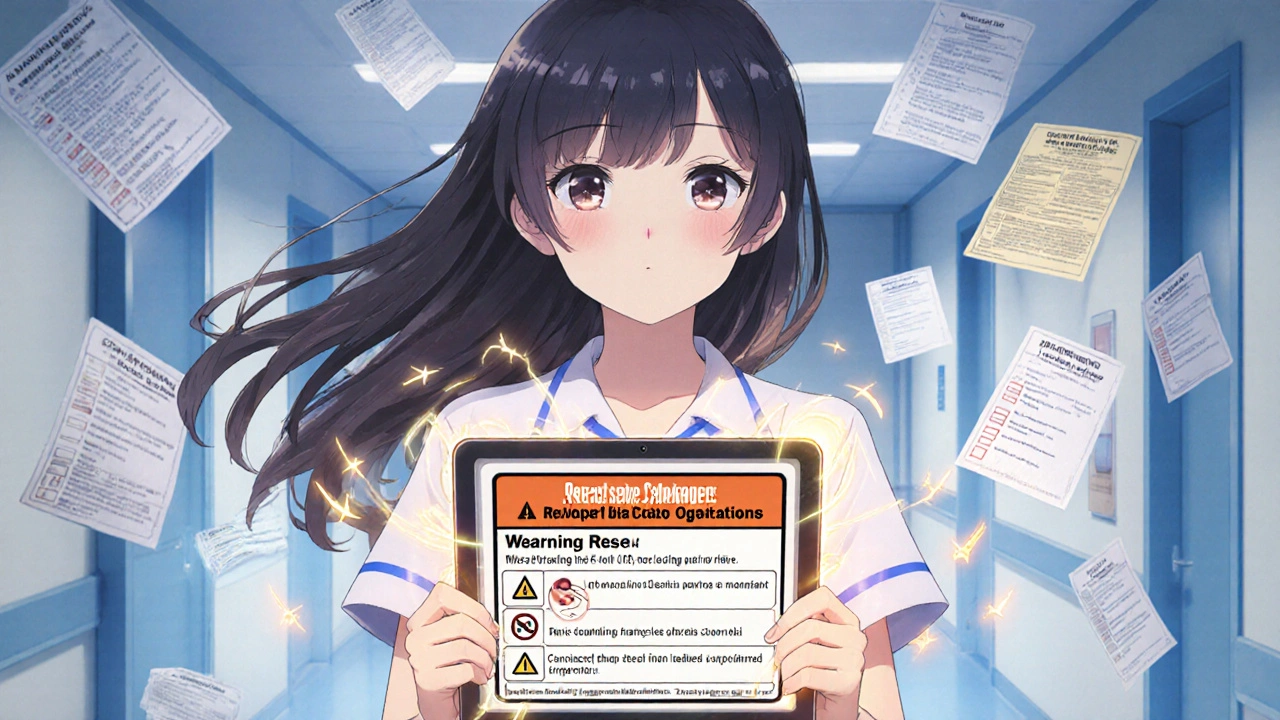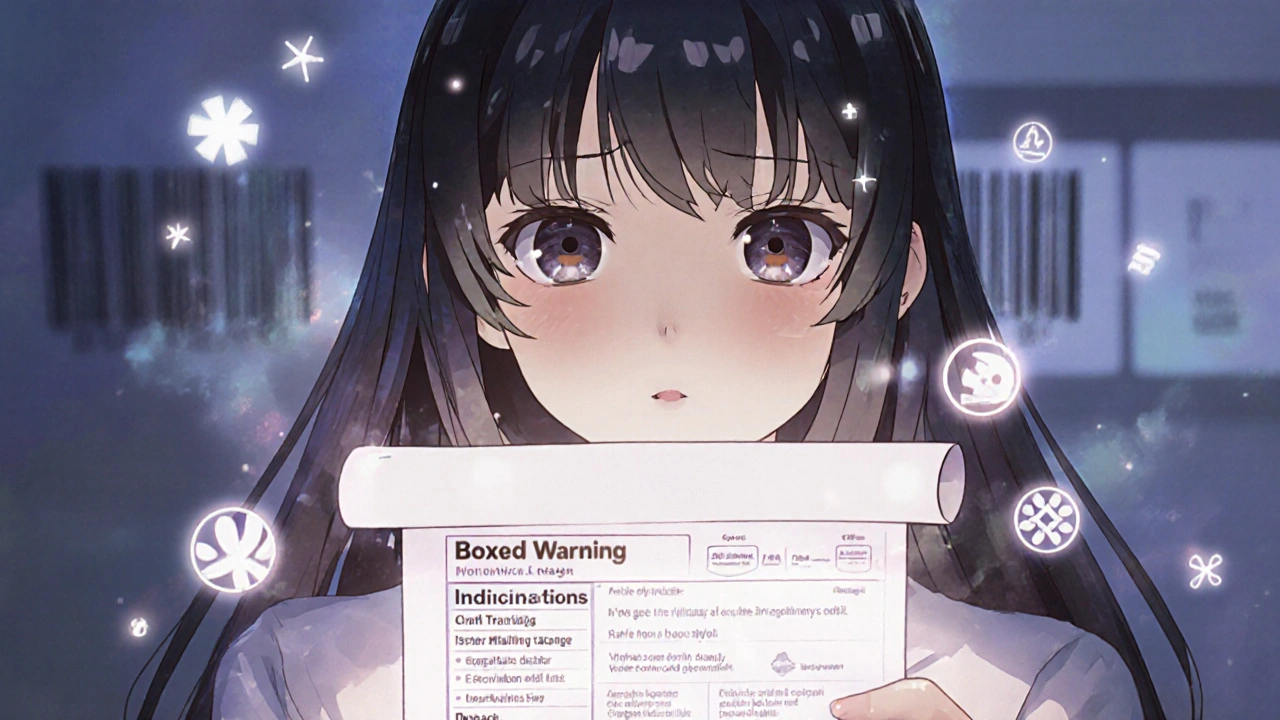Drug Label Priority Guide
This tool helps you identify the most critical sections of FDA drug labels based on your specific health situation. Just answer a few questions, and we'll show you which sections to review first.
Every time you or someone you care about takes a prescription, there’s a detailed document behind it - the FDA drug label. It’s not just a piece of paper. It’s a legally binding, scientifically rigorous guide that tells doctors exactly how to use a medicine safely. But if you’ve ever looked at one, you know it’s overwhelming. Hundreds of lines. Strange terms. Sections that seem to go on forever. The truth? You don’t need to read every word. You just need to know where to look - and what matters most.
What You’re Actually Looking At
The official FDA drug label is called the United States Prescribing Information (USPI). It’s not written for patients. It’s written for doctors, pharmacists, and other healthcare providers. But understanding it can help you ask better questions and avoid dangerous mistakes. The label is split into three main parts: the Highlights, the Table of Contents, and the Full Prescribing Information (FPI). The Highlights section is just half a page long - it’s meant to give you the top-line facts. But here’s the catch: it’s incomplete. The FDA requires it to include a disclaimer saying so. That means if you only read the Highlights, you’re missing critical details. The real power is in the FPI - 17 structured sections, each with a specific purpose.
Section 1: Indications and Usage
This is where you find out what the drug is actually approved to treat. Not what it’s used for off-label. Not what your friend says it helps with. Only what the FDA has reviewed and approved. For example, a drug might be approved for type 2 diabetes, but not for weight loss - even if some doctors prescribe it for that. The label will also include the drug’s Established Pharmacologic Class (EPC), which tells you how it works in the body. If it says “SGLT2 inhibitor,” you know it blocks sugar reabsorption in the kidneys. This isn’t just jargon - it helps you understand why the drug might interact with other meds or affect certain health conditions.
Section 2: Dosage and Administration
This is the most commonly misread section. It tells you how much to take, how often, and how to take it - but it’s more than just “take one pill daily.” It includes dose adjustments for people with kidney or liver problems, for children, for older adults, and even for patients on dialysis. The FDA updated guidance in March 2024 to make these adjustments clearer. If you’re over 65 or have chronic kidney disease, this section could mean the difference between a safe dose and a toxic one. Never assume your regular dose is right for everyone. Always check if the label says “reduce dose in renal impairment.”
Section 5: Warnings and Precautions - Especially the Boxed Warning
Every FDA label with serious risks includes a Boxed Warning - the strongest safety alert the agency can issue. It’s printed in a thick black border at the top of the label. This isn’t a suggestion. It’s a red flag. Boxed Warnings cover life-threatening risks like heart failure, liver damage, suicidal thoughts, or severe allergic reactions. A 2020 NCBI analysis found that over half of medication errors linked to labeling were due to missed warnings. If a drug has a Boxed Warning, you need to know what it is before taking it. For example, some antidepressants carry a Boxed Warning for increased suicide risk in young adults under 25. This doesn’t mean you shouldn’t take it - but you need to monitor for signs and report them immediately.
Section 6: Adverse Reactions
This section lists side effects, but not all side effects are equal. The label breaks them down by frequency: very common (over 10%), common (1-10%), uncommon (0.1-1%), and rare (under 0.1%). It also separates side effects from clinical trials from those reported after the drug hit the market. If a side effect shows up in 15% of patients in trials, it’s not an anomaly - it’s expected. But if something only happened in one person after millions took the drug, it’s likely rare. Don’t panic over every listed side effect. Focus on the ones that match your health history. If you have heart disease, pay attention to cardiac side effects. If you’re prone to depression, watch for mood changes.

Section 7: Drug Interactions
Drugs don’t work in isolation. This section tells you which other medications, supplements, or even foods can change how the drug works. Some interactions are deadly. For example, taking certain antibiotics with statins can cause muscle damage. Grapefruit juice can make some blood pressure drugs dangerously strong. The label lists interactions by severity: major, moderate, minor. A major interaction means you should avoid combining them. A moderate one might require a dose change. Always tell your doctor and pharmacist everything you’re taking - even herbal supplements. The FDA’s 2023 labeling report showed that 42% of drug interaction errors happened because providers didn’t check this section.
Section 8: Use in Specific Populations
Pregnant? Breastfeeding? Over 65? Under 18? This section answers your specific questions. Many drugs are not tested in pregnant women, so the label will say “use only if clearly needed.” For older adults, it might say “increased sensitivity” or “lower starting dose recommended.” For kids, it often says “safety and effectiveness not established.” Don’t assume a drug is safe just because it’s prescribed. The FDA requires this section because people in these groups often respond differently - and they’re at higher risk of harm if the label isn’t followed.
Section 16: How Supplied / Storage and Handling
This is where you find the 10-digit National Drug Code (NDC). It’s not just a barcode. It tells you the exact manufacturer, product, and packaging. If you get a different-looking pill from the same prescription, check the NDC. Look-alike/sound-alike errors cause 12.7% of dispensing mistakes, according to the Institute for Safe Medication Practices. This section also tells you how to store the drug - some need refrigeration, others must be kept away from light. If your pill looks different, smells odd, or doesn’t match the NDC on your bottle, don’t take it. Call your pharmacist.
Section 17: Patient Counseling Information
This is the only part of the label written for patients. It’s a checklist of things your doctor or pharmacist should tell you: how to take it, what to avoid, what side effects to watch for, and when to call for help. But here’s the problem: only 38.2% of providers use it, according to a 2024 audit of 2,500 patient visits. Don’t wait for them to bring it up. Ask: “Is there anything in the Patient Counseling section I should know?” You’ll be surprised how often they haven’t read it themselves.

What’s New? The Recent Major Changes Section
Since 2018, every label must include a “Recent Major Changes” section. It lists every part of the label that’s been updated in the last six months. This is critical. A drug’s safety profile can change overnight. A new warning, a dose adjustment, a new interaction - all of it gets added here. The FDA says labeling updates happen every 14.3 months on average. If you’ve been on a drug for years, check this section every time you refill. It could save your life.
How to Use This Like a Pro
Doctors don’t read the whole label every time. They use a shortcut: Boxed Warning → Highlights → Indications → Dosage → Drug Interactions. That’s it. That’s where 90% of the critical info lives. If you’re a patient, do the same. Start with the Boxed Warning. Then check the Highlights for the approved use and basic dosing. Then flip to Section 7 and see if anything you’re taking could interact. If you’re unsure, print the label or pull it up on the FDA’s website. Don’t rely on your pharmacy’s printout - it’s often a summary, not the full label.
Why This Matters More Than Ever
The FDA’s entire drug labeling system runs on Structured Product Labeling (SPL), an XML format that feeds into electronic health records, pharmacy systems, and drug databases. Over 98% of U.S. hospitals pull drug info directly from these FDA submissions. That means if the label is wrong, your EHR is wrong. And if your doctor’s computer shows outdated info, they might prescribe something unsafe. That’s why the FDA is pushing for faster updates - aiming to cut the time between a safety change and a label update from 17 days to under 7 by 2026. But until then, you’re the last line of defense. If something doesn’t look right, ask. If the pill looks different, check the NDC. If the side effects scare you, read Section 6. You don’t need to be a doctor. You just need to know where to look.
What’s Coming Next
The FDA’s “Patient-Focused Labeling Initiative,” announced in October 2024, could change everything. By 2025, new labels may include plain-language summaries, visual icons for risks, and even QR codes linking to video instructions. The goal? Reduce medication errors by up to 29%, as shown in a Johns Hopkins study. But for now, the system we have - complex, dense, and legally binding - is what you’re working with. And if you learn how to read it, you’re no longer just a patient. You’re an informed partner in your care.
Can I rely only on the Highlights section of the FDA drug label?
No. The Highlights section is designed to give a quick overview, but it’s intentionally incomplete. The FDA requires it to include a disclaimer stating that it does not contain all the information needed for safe use. Critical details like dosage adjustments for kidney disease, drug interactions, and boxed warnings may not appear in full here. Always refer to the Full Prescribing Information for complete safety and usage guidance.
What is a Boxed Warning and why is it important?
A Boxed Warning is the strongest safety alert the FDA can require on a drug label. It’s printed in a thick black border at the top of the label and highlights life-threatening risks such as heart failure, liver damage, suicidal behavior, or severe allergic reactions. These warnings are based on clinical data and postmarket reports. Ignoring a Boxed Warning can lead to serious harm or death. Always read it before starting a new medication and discuss it with your provider.
How do I know if my medication has been updated recently?
Look for the “Recent Major Changes” section on the FDA drug label. Since 2018, every label must include this section, listing all updates made in the past six months - including new warnings, dosage changes, or added drug interactions. If you’ve been taking a medication for a while, check this section every time you refill your prescription. Updates can happen even if the pill looks the same.
What should I do if my pill looks different from last time?
Don’t take it. Check the 10-digit National Drug Code (NDC) on the bottle and compare it to the NDC listed in Section 16 of the FDA label. If they don’t match, the pill may be from a different manufacturer or even a different drug entirely. Look-alike/sound-alike errors cause nearly 13% of dispensing mistakes. Call your pharmacy immediately and ask them to verify the medication before you take it.
Is the Patient Counseling Information section meant for me?
Yes. Section 17 is the only part of the FDA drug label written specifically for patients. It includes key points your doctor or pharmacist should discuss with you - like how to take the drug, what to avoid, and when to seek help. But studies show only about 38% of providers use it. Don’t wait for them to bring it up. Ask: “Is there anything in the Patient Counseling section I should know?” You have the right to this information.
Next time you get a prescription, don’t just take the pill. Take five minutes to look up the label. The FDA made it for you - even if it wasn’t written for you. Knowing how to read it puts control back in your hands.


Ross Ruprecht
Ugh I just read the Highlights and thought I was good to go. Turned out my pill looked different this month and I almost swallowed a whole different drug. Thanks for the NDC tip - I’m printing the label now before I take anything else. 🙃